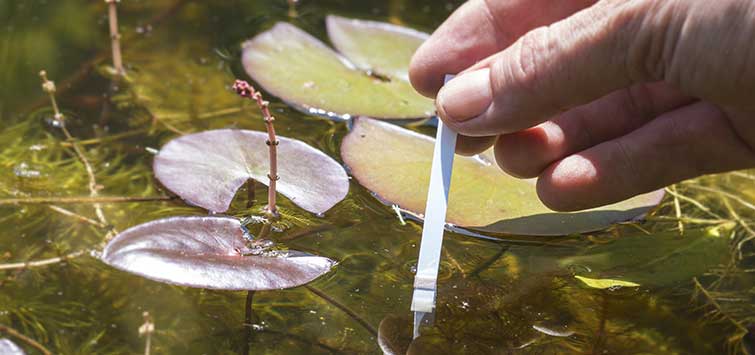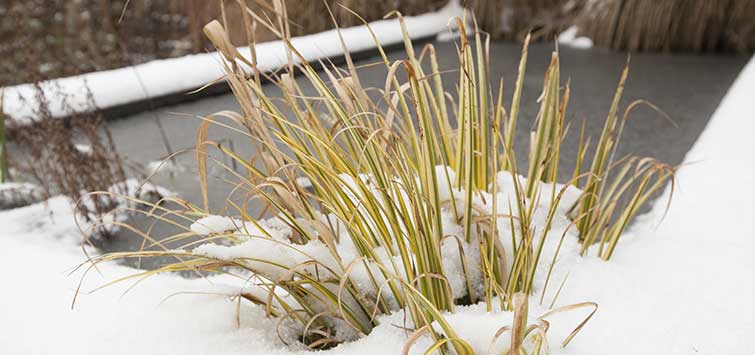The Skeptical Fishkeeper: Spring Ponds
Author: Laura Muha
I always start to get a little nervous somewhere around the beginning of March. It’s not that I don’t like spring; I detest the cold of Northeastern winters, and as far as I’m concerned, the warm weather can’t get here fast enough.
But I also know that as the weather warms up, many shifts will occur in my 500-gallon backyard pond, and I’m not always sure how to shepherd my goldfish through them. When do I turn on the filter? How about the waterfall? Should I give my pond the aquatic equivalent of a spring housecleaning? How do I protect my fish against the bacteria, water molds, and parasites that become more prevalent as the weather warms and the pond begins to stir? Should I add salt? As is often the case, the answers to such questions seem to depend on who you talk to.
So when Dr. Julius Tepper, a Long Island fish veterinarian, told me he was going to be making a series of spring checkups on clients’ ponds, I jumped at the chance to accompany him—and to bring the readers of this column along for the ride. Although most of us don’t have access to a fish vet willing to make pond calls, Tepper assured me there were plenty of simple things we could do to better manage our ponds—and keep our fish healthy—during this transitional time of year.
A Fluctuating Ecosystem
The first thing to remember, Tepper told me as we drove through morning rush-hour traffic on the Long Island Expressway, is that the pond you have this year is not the pond you had last year at the same time, even if you haven’t made any deliberate changes to it. That’s because a pond is an ecosystem, and like all ecosystems it changes over time in response to variables far beyond our control.
In indoor aquariums we’re able to regulate the temperature, lighting, and the addition and removal of water, which in turn gives us at least some control over what’s going on in the tank. But in a pond all of these things are subject to the weather, which varies (sometimes significantly) from one year to the next. For instance, one winter may be warmer than average, the next colder, and there may be record precipitation or barely any.
In addition, the bioload of a pond also gets bigger as the fish grow. And if you want to split hairs, he said, the pond technically gets smaller, because as the fish get larger, “they take up room that used to be for water.”
Managing Ecosystem Changes
All of those things set off chain-reaction changes in the pond ecosystem, which helps to explain, for instance, why we might have an algae bloom or disease outbreak one year, and none the next. But that doesn’t mean we have to sit back, helpless, in the face of such changes, Tepper said. There are lots of ways to manage them—as long as you can identify them before they get out of control. And to do that, he suggests conducting a pond checkup at least twice a year, in the spring and the fall.
“I divide a checkup into three areas: water quality, examination of fish, and a going-over of the system to make sure everything looks good and is working correctly,” Tepper said. It was 9 a.m. and we’d just pulled into the driveway of a beige, two-story house in a quiet Long Island neighborhood. After greeting homeowner David Schiffman, Tepper led the way to the backyard, where three years earlier Schiffman and his wife had installed a gorgeous 13,000-gallon pond that made my own look like a bathtub.
Inspecting the Fish
Tepper crouched on a rock at the edge of the pond as a posse of goldfish and koi swam over to inspect him. He inspected them right back, looking for shredded or blood-streaked fins, lesions, cloudy eyes, or any other noticeable markings. “Typically, the biggest problem I see at this time of year are ulcers,” he said. “A lot of times it’s just a little red spot, like a pimple, to start.”
Fortunately, Schiffman’s fish looked good. “I don’t see any with lesions at all except possibly the shagoi,” Tepper said, pointing to a beautiful brown koi. “See that little red dot right on the middle of his back, between the dorsal fin and the tail? It’s probably just a scale that got flipped up, but it could be the start of an ulcer.” Either way, it didn’t look significant enough to warrant stressing the fish by pulling it out of the pond for a closer look; rather, Tepper advised Schiffman to keep an eye on things and to call immediately if the problem got worse.
Taking the Temperature
Next, Tepper pulled a thermometer from a tackle box and noted the water temperature: 58°F. Even though Schiffman’s pond gets a lot of sunlight, it’s so big that the water temperature is unlikely to vary much during the course of the day, Tepper said. But in smaller ponds like mine, the water temperature can shift more rapidly and stress the fish, so it’s a good idea to take the temperature several times during the course of the day to see how much it’s fluctuating. If the temperature is changing by more than a degree or so, then it’s important to find ways to shade the pond.
It’s also important not to turn on waterfalls, fountains, bubblers, or other aeration systems too early in the season, Tepper said. While he does recommend continued slow circulation of the water during the winter months, he prefers doing so via a waterfall bypass—essentially sending water from the filter back into the pond via a pipe that lies below the surface of the water. This helps make sure that the filtered water doesn’t come into contact with the air. That’s because the air temperature tends to fluctuate widely at this time of year, and the more water that comes into contact with it, the more the temperature of the water will fluctuate, too—something that stresses the fish and could make them more prone to illness, Tepper said. Besides, it’s not necessary to aerate water that’s below 60°F because the cooler water holds plenty of oxygen, he said, adding that when water reaches and stays at that temperature, it’s time to turn on the waterfall.
Gathering Samples
Pulling some vials from his tackle box, he prepared to take a series of water samples from Schiffman’s pond. “You always want to take them from where the worst water is likely to be, not from a spot [such as the filter outflow] where it’s already been processed. And don’t take it from the surface,” Tepper said, explaining that the condition of water at the surface isn’t necessarily reflective of water at deeper levels of the pond, especially when the filter is off, as it is in many ponds during the winter.
That’s particularly true in benthic systems such as Schiffman’s, because they’re lined with rocks and organic waste that tends to build up in the crevices between them. Eventually it will be broken down by bacteria, but the process takes a lot longer than it does in bare-liner systems like mine, where the waste is more easily pulled out by the filter. As a result the bioload in benthic ponds can get pretty heavy, and if the pond is overstocked, problems can arise, particularly in the summer when the water gets warm, Tepper said. Fortunately, Schiffman has a much larger margin for error than many pondkeepers, because he doesn’t overstock and has a much larger filtration system than he needs. “But most people do not have that kind of extra capacity,” Tepper stressed.
pH Test
Drawing a couple of samples from a quiet inlet in the pond, he checked the pH of the water, which was a perfect 7.8, then inserted a sample into a turbidity meter to check for the presence of undissolved solids in the water—solids that could potentially irritate the gills of the fish. “Six. That’s high for this pond,” he said, checking the reading against notes he’d made on previous visits to the pond, then setting it aside to look at again in a little while. Keeping a log of readings, he explained, is a good idea for any pondkeeper because it helps determine what’s normal for a particular pond, and it allows us to identify shifts in water chemistry before they can lead to problems.
Ammonia and Nitrates Test
Tepper next conducted tests for ammonia (none) and nitrites (ditto), followed by a nitrate test—something that’s neglected by many pondkeepers, but which he considers “a bellwether” for pond health. He’s consistently found that the higher the nitrate levels, the more likely the fish are to develop problems over time. “I tell clients to try and keep them below 25 and never let them get above 50,” he said, noting with satisfaction that the levels in Schiffman’s pond were negligible. “I’ve had ponds that were so pristine that you’d think you could eat in them—and then the client calls because there’s been an ulcer outbreak, and when I check the nitrites, they’re off the charts.”
Salt Check
He also checked for salt, which is something many pondkeepers add to their water; but Tepper discourages it. “I’m fairly adamant that people should not routinely use salt in koi ponds,” he said. “Most people have absolutely no idea how salt works. I can’t give you any good reason for using it, and several for not using it in a koi pond.” For one thing, water with salt in it holds less oxygen than water without it; for another, salt is a medication, and pondkeepers who use it as a preventive may find that it becomes less useful as a medication over time.
Filtration and Clean Water
“What about spring cleaning?” I asked. Some pondkeeping friends insist that it’s necessary, and they actually go so far as to pull their fish out once a year so they can drain the pond and powerwash the liner.
Tepper shuddered. “That’s one of the scariest things people tell me,” he said, explaining that a pond is a complex ecosystem, and that over a period of several years, it tends to reach a natural balance. But when people drain their ponds and scrub them down, they’re destroying all the beneficial organisms that grow on the sides and the rocks, essentially sending the pond back to the beginning. “They muck everything out and throw the fish back in. It really throws the fish into crisis,” he said.
Checking Up
Walking around the side of the house, he checked Schiffman’s massive filtration system, which consisted of a series of enormous canisters. “Mostly, I just look to see how much grunge is building up,” Tepper said. Peering inside one of them, he noted that it was filled with bags of media. “I’m not crazy about this,” Tepper said, noting that the water could channel between some of the bags, creating dead zones.
Returning to the patio, he re-checked the turbidity reading, which was now at 4—meaning that there were some solids in the water that were settling out.
“The water is not as clear as it has been,” Tepper told Schiffman. “It could be the start of an algae problem.”
Promising to investigate more closely when he got back to his lab, he bade Schiffman good-bye and loaded his equipment back into his SUV. Then, after we washed our boots down with disinfectant to prevent tracking problems from one pond to the next, we hit the road again en route to our next call.
Next month: The good, the bad, and the ugly …

.png?h=595&iar=0&w=2781&hash=5FD5E69473BCC22199FBFA2FB71B6033)



